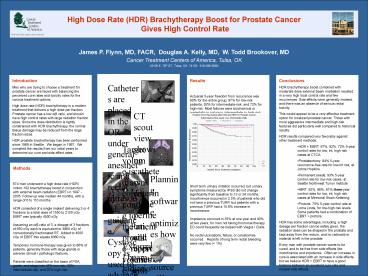Conclusions - PowerPoint PPT Presentation
1 / 1
Title:
Conclusions
Description:
Side effects were generally modest, and there was an absence of serious rectal toxicity. ... Every man with prostate cancer wants to be cured, and to be free from side ... – PowerPoint PPT presentation
Number of Views:18
Avg rating:3.0/5.0
Title: Conclusions
1
High Dose Rate (HDR) Brachytherapy Boost for
Prostate Cancer Gives High Control Rate
James P. Flynn, MD, FACR, Douglas A. Kelly, MD,
W. Todd Brookover, MD Cancer Treatment Centers of
America, Tulsa, OK 10109 E. 79th ST., Tulsa, OK,
74133. 918-286-5060
- Conclusions
- HDR brachytherapy boost combined with moderate
dose external beam irradiation resulted in a very
high local control rate and few recurrences. Side
effects were generally modest, and there was an
absence of serious rectal toxicity. - This would appear to be a very effective
treatment option for localized prostate cancer.
Those with more aggressive intermediate and
high-risk features did particularly well compared
to historical results. - HDR results compared very favorably against other
treatment methods - HDR EBRT 97, 92, 72 5-year control rates
for low, int, high risk cases at CTCA. - Prostatectomy 84 5-year recurrence-free rate
for low-int risk, at Johns Hopkins - Permanent seeds 93 5-year control rate for low
risk cases, at Seattle Northwest Tumor Institute - IMRT 92, 86, 81 three-year control rates for
low, int, high risk cases at Memorial Sloan
Kettering. - Protons 75 5-year control rate at Loma Linda,
for low-high risk levels. Some patients had a
combination of EBRT protons. - HDR has some advantages, including a high dosage
per fraction can be safely given, the radiation
dose can be shaped in the prostate and kept away
from the rectum, and no radioactive material is
left in the prostate - Every man with prostate cancer wants to be cured,
and to be free from side effects like
incontinence and impotence. Often an increase in
cure is associated with an increase in side
effects, but we believe HDR EBRT to have a good
balance between an excellent cure rate and modest
side effects.
Introduction Men who are trying to choose a
treatment for prostate cancer are faced with
balancing the perceived cure rates and toxicity
rates for the various treatment options. High
dose rate (HDR) brachytherapy is a modern
treatment that delivers a high dose per fraction.
Prostate cancer has a low a/ß ratio, and should
have high control rates with large radiation
fraction sizes. Since the dose distribution is
tightly constrained with HDR brachytherapy, the
normal tissue damage may be reduced from the
large fraction sizes. HDR prostate brachytherapy
has been performed since 1989 in Seattle. We
began in 1997. We compiled the results from our
initial years to determine our cure and side
effect rates.
Results Actuarial 5-year freedom from recurrence
was 90 for the entire group 97 for low-risk
patients, 92 for intermediate-risk, and 72 for
high-risk. Most failures were biochemical or
metastatic in nature in intermediate or high-risk
patients, occurring especially in the first 3
years. Short term urinary
irritation occurred, but urinary symptoms
measured by IPSS did not change significantly
from baseline to 12 or 24 months. Incontinence
occurred in 2.5 of patients who did not have a
previous TURP, but patients with a previous TURP
had a 15.8 increase in incontinence. Impotence
occurred in 35 at one year and 40 at two years,
for men not taking hormonal therapy. ED could
frequently be helped with Viagra / Cialis. No
rectal ulcerations, fistula, or colostomies
occurred. Reports of long term rectal bleeding
were very few (lt 1).
Catheters are placed in the OR under general
anesthetic and rectal ultrasound guidance.
Cystoscopy is used to advance catheters up to
bladder mucosa.
CT scout view showing catheters entering the
perineum, and approximating bladder. A template
lightly clamps down on the catheters and is
sutured to the perineal skin.
Target volume is drawn corresponding to the
prostate volume, with extra margins added if
extra-capsular extension is suspected.
Methods 674 men underwent a high dose rate (HDR)
iridum-192 brachytherapy boost in conjunction
with external beam radiation (EBRT) in 1997 -
2005. Follow-up was median 44 months, with a
range of 6 to 110 months. HDR consisted of a
single implant delivering 3 or 4 fractions to a
total dose of 1550 to 2100 cGy. EBRT was
typically 4500 cGy. Assuming an a/ß ratio of 3,
a dosage of 3 fractions of 650 cGy each is
equivalent to 3860 cGy of conventionally
fractionated RT. Added to 4500 cGy of EBRT this
equals 8360 cGy. Temporary hormone therapy was
given to 86 of patients, generally those with
large glands or adverse clinical / pathologic
features. Patients were classified on the basis
of PSA, grade, and stage into 45 low-risk, 35
intermediate-risk, and 20 high-risk.
Planning software optimizes how long the source
will dwell in each location along each catheter
so as to cover the target volume with the
prescribed dose. The 100 dose line is seen to
tightly conform to the target volume. Manual
tweaking can be done to control the dosage to
the rectum and urethra.
Patient will receive a series of 3 fractions over
27 hours. Epidural or PCA IV analgesics are
given. After the final fraction the catheters
are easily removed.
External beam radiation (EBRT) starts
approximately 2 weeks later. Our methods have
evolved over the years from 3D to IMRT and
currently to Tomotherapy.































